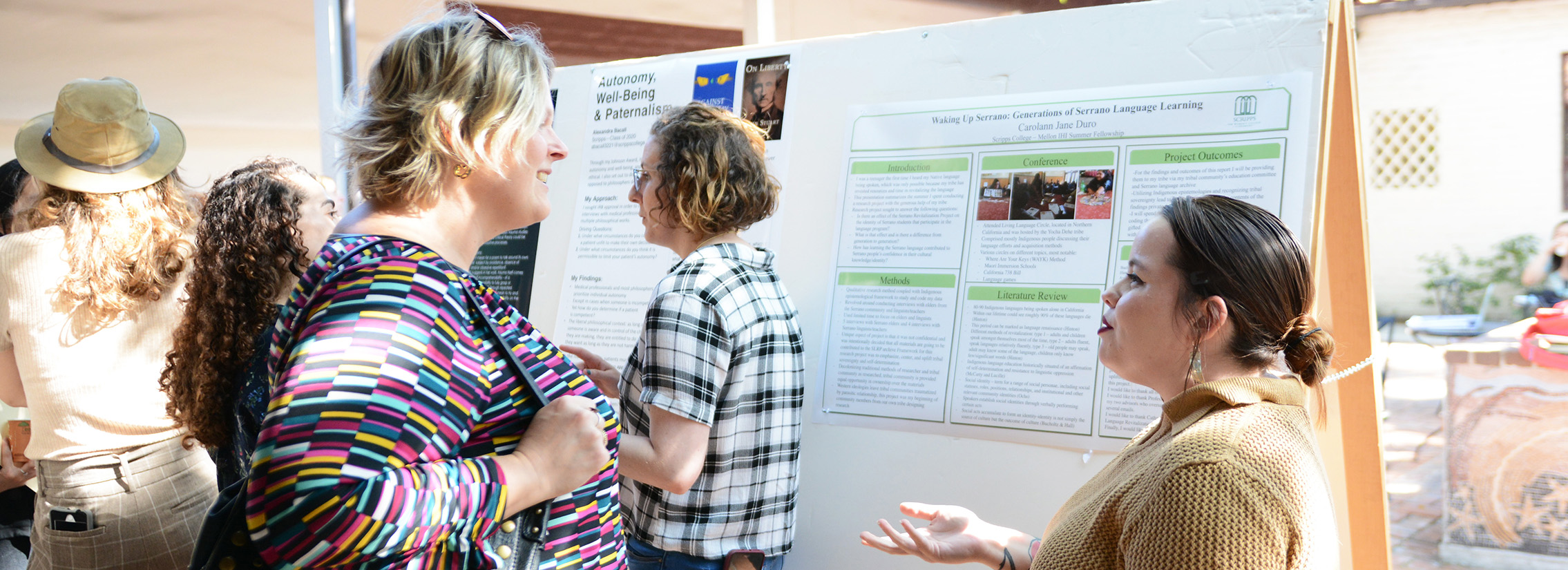 Carolann Duro ’20 presents their summer research on how learning one’s Native language influences their identity at Scripps’ Summer Research Tea this past September.
Carolann Duro ’20 presents their summer research on how learning one’s Native language influences their identity at Scripps’ Summer Research Tea this past September.“Our midnight smudging celebration, where sage is burned for purification, is a time and a space for Native students,” says Carolann Duro ’20. “I’m always challenging the institution to improve resources and community for Indigenous students, but it’s moments like these when I am grateful for the resources we do have and the Native community that is present on these campuses.”
Duro, a sociology major, is a head mentor in the Indigenous Peer Mentor Program, a 5C student-driven collective focused on the communal well-being and development of students identifying with an Indigenous community from across the world. In addition to attending local powwows, attending on-campus talks by Native speakers, mentoring first-year Indigenous students, and participating in various celebrations for Indigenous People’s Day—like the midnight celebration above—the group meets weekly to support each other through the school year. “We have a unique situation as Native students, as many of us have left our reservations—our homelands—to transition into college life,” they say.
Duro is part of the Maara’yam tribe, which they describe as the historical name of the Serrano people, whose traditional territory extends from Palm Springs to Rancho Cucamonga and from Big Bear to Corona. Just west of that territory, comprising large swaths of the Los Angeles Basin, including Claremont, is the historic territory of the Tongva people.
Southern California has been a territorial battleground for centuries, from the Spanish colonization of Mexico to the United States’ acquisition of vast Mexican territories in 1848. Native populations often bore the brunt of these land grabs, suffering violence, diminished populations, and cultural erasure. Today, despite immense population decrease, the Tongva are one of the county’s largest urban Indigenous populations, numbering upwards of 1,500, according to Assistant Professor of American Studies Wendy Cheng’s co-authored book, A People’s Guide to Los Angeles.
With this history in mind, Duro says that despite growing up knowing they were Native, they didn’t understand the importance of learning about their history and traditions until they came to college. “Once I left my reservation, I took on the responsibility of engaging in my community and learning about my culture.”
Today, Duro is passionate about learning Serrano, the native language of their tribe. This past summer, they received a Mellon Interdisciplinary Humanities Summer Fellowship to explore how learning one’s native language influences one’s identity. They currently attend weekly Serrano classes with the hope of teaching other tribe members in the future. After graduating from Scripps, they plan to enroll in a master’s program for Indigenous language revitalization, with the eventual goal of creating films about Native resistance.
Until then, Duro works to educate people about the history of the land. One way is by organizing trips to the Tongva Living History Garden, located at the Chaffey Communities Cultural Center. Founded by Barbara Drake, a Tongva elder and educator in Upland, the garden tells the story of colonization through plants. The garden includes Native plants as well as flora imported during Spanish colonization. “It is important for all students, not just Native students, to visit the Tongva Living History Garden to learn about the violent history of the land they are living on,” says Duro.
They also emphasize the importance of challenging institutions to do more to support Native people. “I don’t think the burden should solely fall on Native people to remind others that we are on Indian land, but I do think we have a beautiful resilience. Wherever we go, we tend to find other Natives and try to raise awareness of our history and current struggles,” they say. “Here at the 5Cs, we push our professors to include more content about Native people.”
According to Jenn Wells, assistant dean and director of Scripps Communities of Resources and Empowerment (SCORE), the College hosts programs and workshops aimed at supporting students from marginalized and underrepresented backgrounds, including Native and Indigenous students. “While there is no registered student club/organization based on the Native/Indigenous identity at Scripps specifically, SCORE is available for 5C organizations to use the SCORE space, advertise events on our social media, and partner on programming,” she says. “While we have incorporated land acknowledgement of the Tongva people into the welcomes for our programs, such as the annual Students of Color Dinner, we welcome continued opportunities to partner with Native/Indigenous students to bring more visibility and community to this important population in the Scripps community.”
For Duro, this is a good start, though continued Native presence is key. “Even though there was a campaign of genocide against us, we are still here; we’re not just a relic from the history of the 1800s. We’ve resisted for so long and we continue to resist.”

